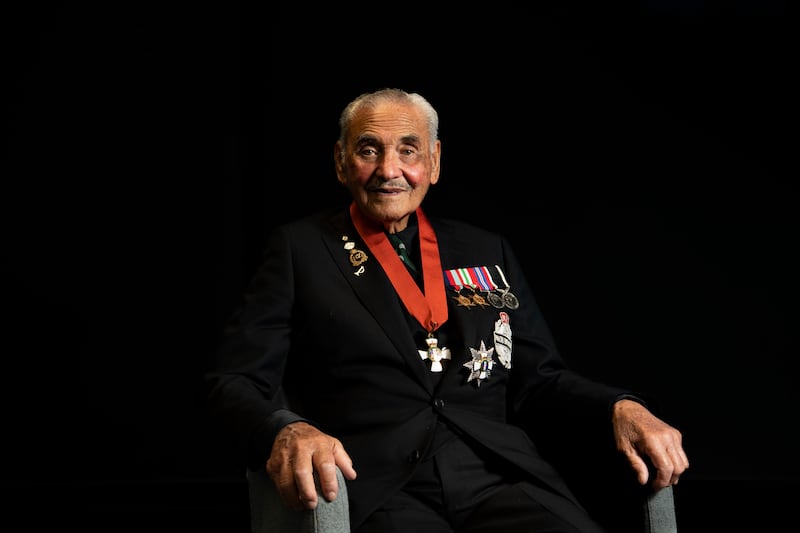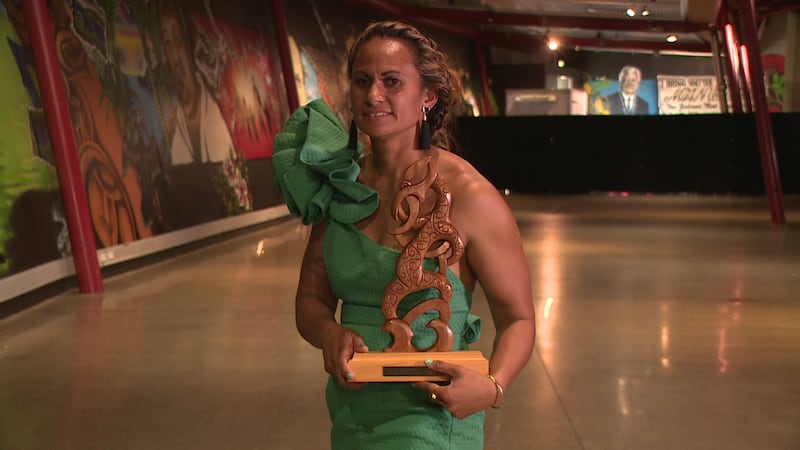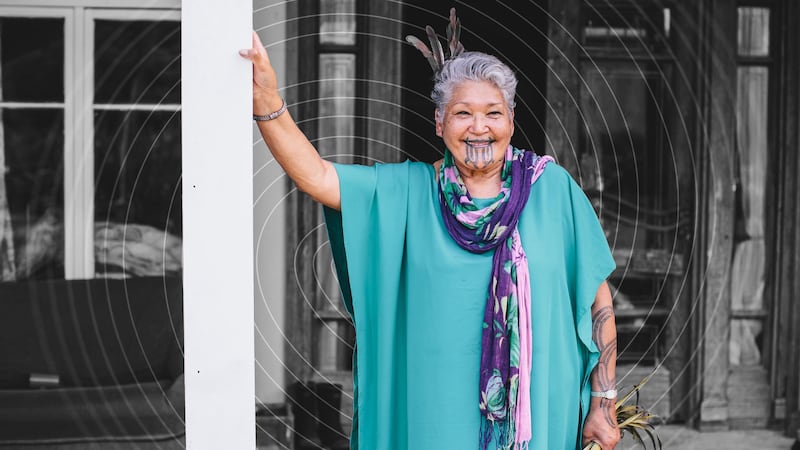When Matariki and Puanga appear in the eastern sky before dawn, it marks a time of reflection and remembrance, and the beginning of Te Mātahi o te Tau, the Māori New Year.
In te ao Māori, death is seen as a transition from the physical world to the spiritual realm, where the spirits of the deceased join the stars. The Pōhutukawa star within the Matariki cluster is associated with those who have passed away.
This year, as part of Matariki commemorations, we acknowledge the passing of a King, a Knight, four Dames, and many other respected and influential members of our communities.
Dame Mabel June Hinekahukura Mariu DNZM QSM JP| 1932 – 2024
Dame June Mabel Hinekahukura Mariu (née Waititi), commonly known as Dame June Mariu, was a foundational force for iwi in West Auckland who had undergone significant upheaval by leaving their traditional kāinga to find better work opportunities.
Born and raised on the East Coast and educated at Queen Victoria School in Parnell, June played a pivotal role in integrating te reo Māori into the New Zealand education system. In the 1980s, she helped establish one of the country’s first school marae at Rutherford College.
In addition to her leadership roles with the Māori Women’s Welfare League and Te Whānau o Waipareira, she was the captain of the first Silver Ferns side to beat Australia.
Some will remember the former Silver Fern standing in supermarket carparks convincing whānau to get heart‑health checks, saving more lives with clipboards than any billboard ever could.
Kiingi Tuheitia Pootatau Te Wherowhero VII | 1955 –2024
“We need to focus on getting in the waka and working together.”
Te Kīngi o te Kotahitanga, King Tuheitia Pootatau Te Wherowhero VII, began his reign as an unknown figure to many Māori across Aotearoa. Still, by the time of his passing, his cheeky grin was indelibly etched into the memories of those who lived through his era.
As political turmoil engulfed Te Ao Māori following the 2023 election, it was Kiingi Tuheitia who made the call for a hui ā-motu, and Te Ao Māori replied with over 10,000 descending onto Tūrangawaewae Marae.
His tangi would be the defining event of the last decade, marking the rise of a new monarch.
Eddie Robert Low MNZM| 1943 – 2024
Born blind and orphaned young, Eddie Low taught himself guitar by mimicking a manu waiata, earning the moniker ‘Voice in a Million’ after bringing grown men to tears at the Gore Gold Guitar Awards.
He toured prisons for free, convinced that music could crack concrete, and once played through a cancer flare because the hospice ward had lousy acoustics.
Cyril Tainui Chapman | 1954 – 2025
At the age of nineteen, Cyril carried the pou whenua for Dame Whina Cooper’s Land March, later founding Tautoko FM in a derelict pub after the station burned down, convinced Ngāpuhi stories were worth broadcasting in stereo.
It was cancer that dimmed his baritone voice, but not his mischief, and days before he died, he recorded a weather bulletin predicting ‘long‑term sovereignty with intermittent showers of political nonsense’.
Thousands tuned in for the punchline, unaware it would be his last sign‑off.

Sir Robert Nairn ‘Bom’ Gillies KNZM | 1925 – 2024
“War is a waste of time. It solved nothing.”
Sir Bom enlisted underage, weathered Crete and Cassino, then spent half a lifetime avoiding medals because, he said, they belonged to the brothers he buried overseas. At the age of ninety‑seven, he finally accepted a knighthood, using the ceremony to lobby for the battalion’s oral history project. Sir Bom died two years later, with the first recordings funded and underway. Right to the end, he remained a steadfast symbol of humility and service, his presence at commemorations a reminder of the legacy carried by the last soldier of the 28th Māori Battalion.
Ricky Lee Tapuni Mitai | 1988 – 2024
Crowned Manukura Tāne at Te Matatini, Rick was every bit the consummate leader of his kapa, yet never missed Friday fish and chips with his nan in Ōpōtiki. He will forever be tied to the late Koro Bom as ika huirua, and mourners say the night sky split with waiata as two great leaders crossed paths. In death, he still unites kapa haka rōpū who once sparred fiercely, and they now practice his signature double‑leap, promising to land it perfectly in his honour.
Te Rangikaiamokura Wirihana Hetet ONZM | 1937 – 2024
The grandson of legendary carver Tene Waitere, Rangi Hetet, devoted eight decades to coaxing ancestral forms from tōtara while gently reminding politicians that real culture cannot be hurried to meet election dates. When Hurricane Katrina destroyed a marae‑style meeting house he had carved for a Louisiana museum, he wept as if it were a whanaunga, then offered to rebuild it for free, “We carve for people, not for price.”

Kiwi Rina Campbell | 1981 – 2024
World champion Waka Ama paddler, coach, and mother of two, Kiwi Campbell, could silence a boat of teenagers with one raised eyebrow, then hoot louder than them all once the finish line was crossed. She battled post‑natal depression between world titles, openly sharing her scars so other wāhine wouldn’t drown alone. After her sudden passing in November 2024, Gisborne-based paddlers stayed off the Tūranganui river where she trained, turning the awa into a mirror, a gesture as graceful as any gold medal.
Dame Tariana Turia DNZM MBE | 1944 – 2025
“It is our collective responsibility to advance the needs and aspirations of our people, and this should transcend any party-political affiliation.”
She walked out of Cabinet over the Foreshore and Seabed Act in tears of fury and never looked back, founding a party that would swing MMP politics for a decade and pilot Whānau Ora into being. Opponents branded her divisive, yet thousands of coastal Māori credit her for keeping their urupā out of corporate hands. In later years, she chastised both Labour and National with equal impatience, proving that loyalty to your people sometimes means loyalty to no party at all.
Dame Iritana Te Rangi Tawhiwhirangi | 1929 – 2025
Dame Iritana’s revolution began with one simple vow, kia hoki te reo ki te kāinga, yet by the time cancer claimed her, more than 500 kōhanga reo had been established. She had stared down Treasury officials, slept on gym floors to open new centres, and, in her seventies, fronted an embarrassing corporate‑spending scandal that threatened to sink the Kōhanga Reo movement. Instead of hiding, she asked all kōhanga to publish their books online, a transparency unheard of in the sector. Her stubborn refusal to be shamed turned potential demise into renewed funding and, more importantly, hard‑won public trust.

Maata Wharehoka | 1950 - 2025
Maata was raised on Parihaka’s legacy of passive resistance and braided kete for museum displays while secretly teaching weavers to embed protest messages in their patterns. She was arrested twice for blocking oil trucks, yet insisted her greatest act of defiance was feeding the arresting officers her kānga waru (steam pudding made from kūmara) at dawn.
Robyn Fletcher Kahukiwa | 1938 – 2025
“We must look in our own hearts and know that we are a wonderful people.”
Robyn painted goddesses with moko and protest banners in the same stroke, forcing New Zealand galleries to confront colonial narratives they had curated for a century. At book festivals, Kahukiwa often greeted young readers with open arms and lots of aroha, encouraging them with reminders of their tūpuna and belonging, although the exact words she uttered remain in the memories of those she met.
Frederick John Graham CNZM | 1928 – 2025
Fred Graham’s sculptures of towering steel birds can be seen in many city plazas now, but in the 1960s, he was told Māori art belonged only on the walls of marae. He answered by welding iron feathers the size of sails and planting them outside universities. Later, when he was asked to accept an Icon Award limited to twenty living artists, he replied, “Make it twenty‑one, we can’t leave Kuia Hiria out.”
Lady Arapera Sharples | 1957 – 2025
While Sir Pita stood beneath parliamentary spotlights, Lady Arapera occupied the margins, organising community hāngi to fund kōhanga reo, slipping pocket money to solo mums, and reminding high‑profile activists to eat before marching. Her whānau speak of the nights she shouldered the grief of strangers who turned up at her door, convinced she could fix whatever ailed them. It was that invisibility‑by‑choice which shocked the nation at her tangi: thousands arrived, suddenly aware that the ‘tea‑lady’ in the back row had been the quiet architect of many Māori victories.


